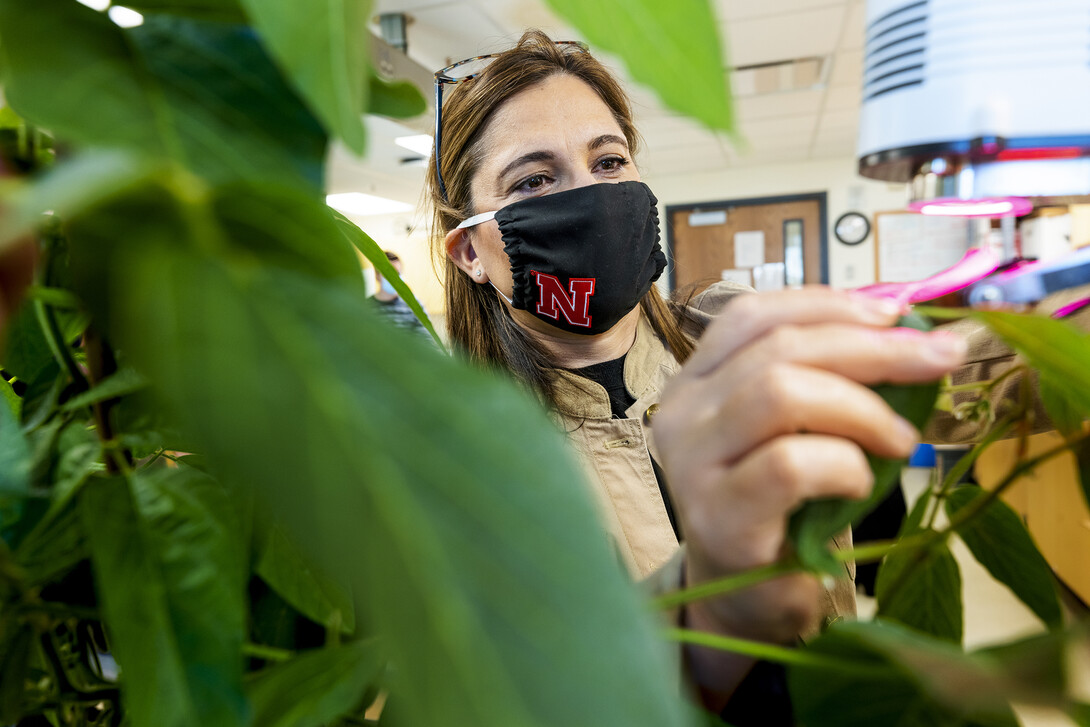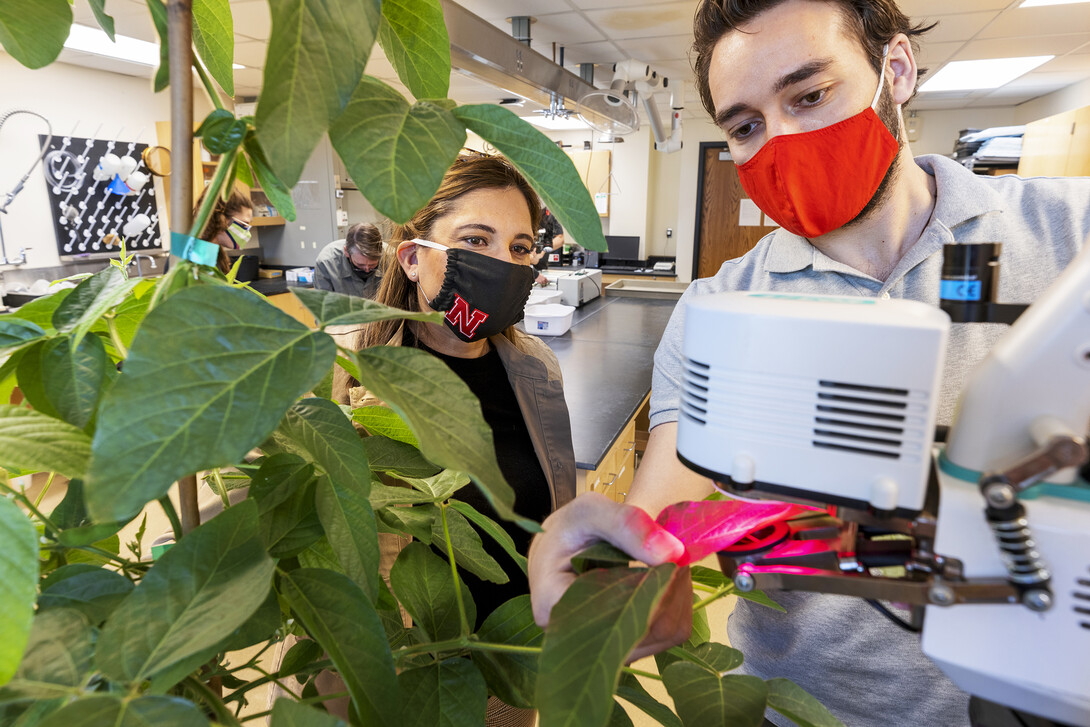
Plants and their environments can tell us much about how the planet is changing, and what may come next.
Tala Awada, a physiological plant ecologist and associate dean for research in the University of Nebraska–Lincoln’s Agricultural Research Division, has spent years learning about climate change through the study of trees and plants. She’s also trekked through the Nebraska Sandhills and the pine forests of Greece to study plants in their environments and solve problems, such as the management of invasive species, changed ecosystems and disease.
Nebraska Today sat down with Awada to talk about her research, how trees and plants act as a window into the future, and what motivated her to become a scientist.

What brought you to the University of Nebraska–Lincoln?
I think at first it was the position itself, and the ability to work in a new ecosystem — the Sandhills of Nebraska. I hadn’t worked in a similar ecosystem before. It was an exciting opportunity to come and work on the ecology of the Sandhills. Twenty years later, we’ve been here and I love the community. I love Lincoln and value the friendships and the connections that we’ve developed.
Were you interested in science or nature as a child?
I think I was a curious kid. I don’t know if I was interested in science, but I was very interested with how things work. I remember that my parents used to give me toys and such, and nothing lasted more than a week. I always had to see how they worked. Even my first watch didn’t make it beyond the week. I was convinced if I put the pieces in sequence, I could disassemble it and assemble it again myself. Obviously, it didn’t work out. I destroyed many toys. I think I was always curious. Finding the specific area I work in now, it came much later, and I think it’s whom you meet throughout your life and how they influence you that really determines where you end up.
Can you give us a summary of your research expertise?
I am a plant ecophysiologist by training, which means I study the physiological interaction of plants with their environment. We can divide this environment into two aspects: the biological environment, such as competition from other plants, microbiome and insects and diseases, and the abiotic environment, which is the temperature, drought, precipitation and so on. This will enable you to understand the mechanisms of plant functions and help you find solutions to problems.
What is the benefit of studying plant ecophysiology in Nebraska?
There is benefit everywhere. I can give you an example. We have issues with the grasslands. One of them is the invasion of Eastern redcedar, or Juniperus virginiana. By understanding how it functions, its efficiency mechanisms, how it grows, reproduces and spreads, how it uses resources, it enables us to manage it better and understand how it will spread in the future with climate change and grasslands management.
Speaking of climate change, what can we glean about it from the study of plants, trees and their ecosystems?
We can glean many things. For instance, I work with tree rings. And I work on the tree rings of invasive species such as Eastern redcedar and expanding species such as ponderosa pine. Also, I work with remnant species such as paper birch that we have along the Niobrara River. By understanding how the trees grow, by examining their annual tree ring growth patterns and their isotopic composition — such as oxygen or carbon — we can understand their response to past environment, their efficiency mechanisms, and forecast how they will respond to climate change and what this means to the community they are in. We just published a collaborative study with the University of Campania in Italy and the Swiss Federal Institute, where we were able to separate the impact of climate change that is due to the increase in atmospheric carbon dioxide from that of our intra- and inter-annual variability in weather. We found that the trees are positively responding to the increase in carbon dioxide irrespective of weather variability. That will give us the ability to understand those trees better, and from that study, we were able to predict that this species is going to continue expanding in the Sandhills. That will have impacts on productivity, diversity and the income of the ranchers, for instance.
Let’s talk about teaching. As a faculty member, what is your central tenet or guiding philosophy in terms of teaching and mentoring your students?
I haven’t taught for a while in my position as associate dean, but I do mentor many graduate students. I look at them as individuals — where they’re coming from, the culture, the ethnicity that they’re coming from — and I help them develop their own path. I want to understand their career goal, or help them find their career goal, and then formulate a mentoring plan that is really customized for their own objectives. I want them to become independent. I want them to develop their critical thinking skills. And I really want them to understand where they want to be in five or 10 years. That helps guide my mentoring principles. There’s no one principle that fits all.
Who mentored or inspired you to pursue a path in science and academia?
I think that goes back many years ago, to when I was doing my master’s in Greece, when I encountered a female scientist, Eleni Constantinidou, who worked in ecophysiology. I was fascinated by her and by the subject matter. I approached her and I asked her if I could do my master’s with her. She said yes. And then it’s history from there. It was one person, one subject, one class.
What can you tell us about Nebraska plants or tree life from your research that might surprise us?
I think about how acclimated and adapted the plants and trees are to our environment. One thing that may surprise you is the remnant forest that we have of paper birch, which is very rare to have in the United States. It’s a remnant boreal forest, and if you know boreal forest, it’s really more in northern Canada. That area escaped some of the glaciation many thousand years ago, and it’s still surviving to now. It’s on canyons facing north, along areas of the Niobrara River. It’s in a very unique microclimate that allowed it to continue, but it is in danger of climate change, of other species invading, which are changing the water cycle and impacting the environment. Not many people know about this remnant forest, but it’s something very unique to Nebraska.

What are some plants that Nebraskans can use in their yard or their garden that are especially hardy and can survive?
There are many of them. For trees, I like the spruces and the firs. Also, there are the oaks. I would stay away now from the ashes because of the insects and diseases. The pines are great. There are many species that we can grow here, and that depends on the preference and the function of it. Whether you want to use shade, whether you want more sun, it all depends, but there are a lot of options.







